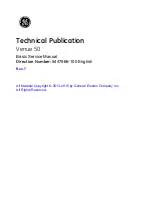
2
Functional Description
Mass Spectrometer
Thermo Scientific
TSQ Quantum XLS Series User Guide
37
Mass Analyzer Lenses
The TSQ Quantum XLS Series mass analyzers have three lens sets. See
.
Those between Q1 and Q2 are designated L21, L22, L23; those between Q2 and Q3 are
designated L31, L32, L33; and the lens between Q3 and the ion detection system is
designated the exit lens. All of the lenses have circular holes in their centers that the ion beam
passes through.
The lens assemblies also retain the three rod assemblies to ensure accurate and automatic axial
alignment of the rod assemblies.
The L2
x
lens set (between Q1 and Q2),where x=1,2,3, and the L3
x
lens set (between Q2 and
Q3) serve these functions:
• To minimize the amount of collision gas that enters the mass analyzers (Q1 and Q3) from
the collision cell (Q2). Lenses L22 and L21 on one side of Q2 and lenses L32 and L33 on
the other side of Q2 act as baffles. (For high-mass transmission, be sure to maintain a low
pressure in the mass analyzers.)
• To retain the collision gas. Lenses L23 and L3 form two of the walls of the collision cell,
so they tend to hold the collision gas in the collision cell. The collision gas escapes,
however, through the same lens holes that the ion beam passes through.
• To shield Q1 from the rf voltage applied to Q2 and vice versa (L2
x
lens set) and to shield
Q3 from the rf voltage applied to Q2 and vice versa (L3
x
lens set).
• To focus the ion beam. The three lenses between Q1 and Q2 (and those between Q2 and
Q3) together form a three-element aperture lens. The first and third lenses are generally
set to similar or identical values and the central lens is set to a value different (either
higher or lower) from the other two.
The voltage applied to each of the lenses can vary from about –300 to +300 V. Typically,
however, the voltage applied to the first and third elements of the L2
x
lens set is somewhat
greater than the quadrupole offset voltage applied to Q1. Because the Q1 quadrupole offset
voltage is generally set to about ±5 V (depending on the charge of the ions of interest), the
voltage applied to lenses L21 and L23 is typically about –10 V for positive ions and +10 V for
negative ions. The voltage applied to the central lens of the L2
x
lens set is typically about
±225 V.
In the Q3MS scan mode, the voltage applied to the lenses of the L3
x
lens set is about the same
as that applied to the corresponding lens in the L2
x
lens set. Note, however, that in the
MS/MS scan modes, the voltage applied to the L3
x
lens set automatically varies with the
quadrupole offset voltage applied to Q3. As the Q3 quadrupole offset voltage ramps, the
voltages applied to the lenses ramp correspondingly.
The exit lens is located between Q3 and the ion detection system. The exit lens is held at
ground potential. Its purpose is to shield Q3 from the high voltage applied to the ion
detection system and to shield the ion detection system from the high rf voltages applied
to Q3.
















































